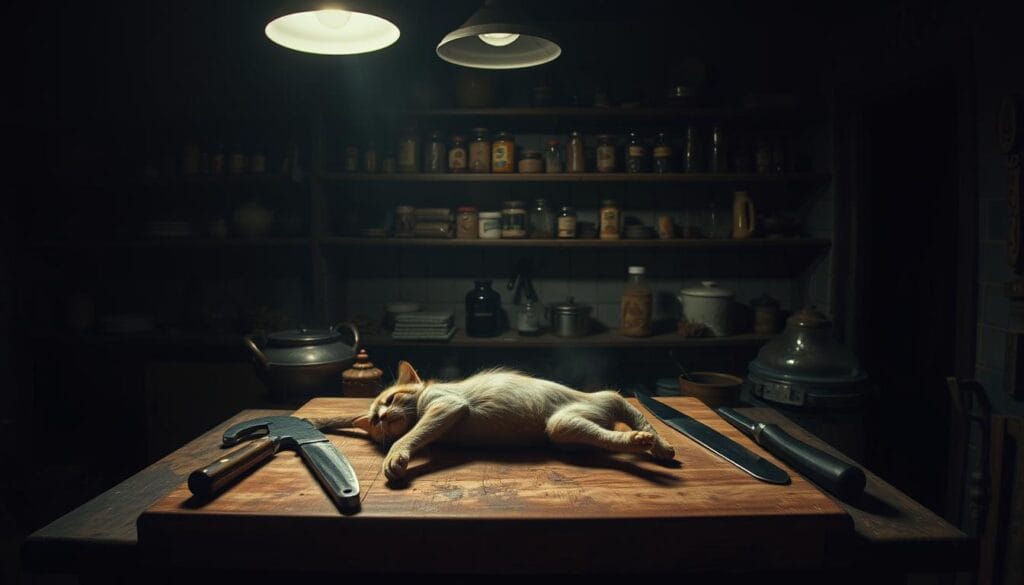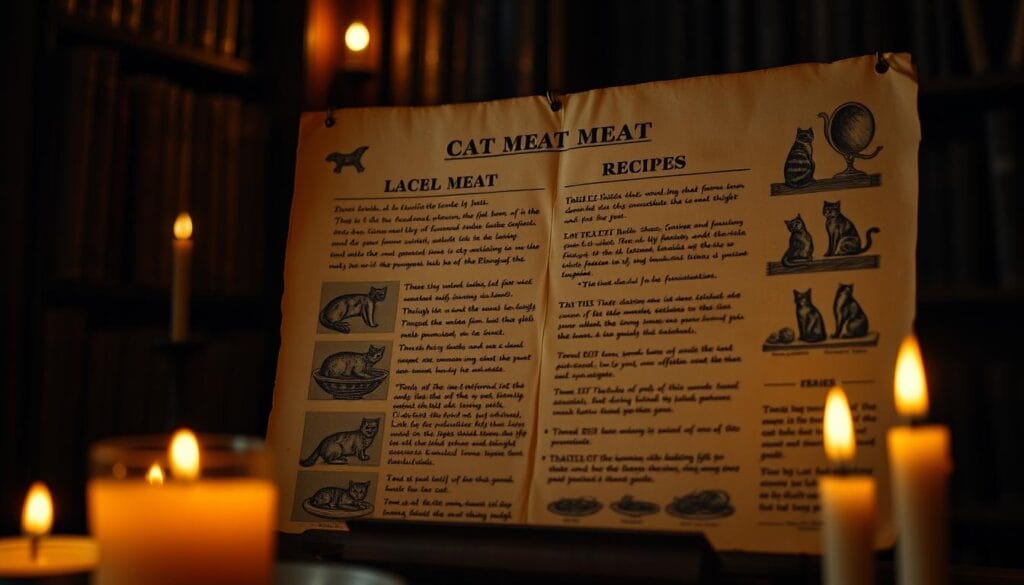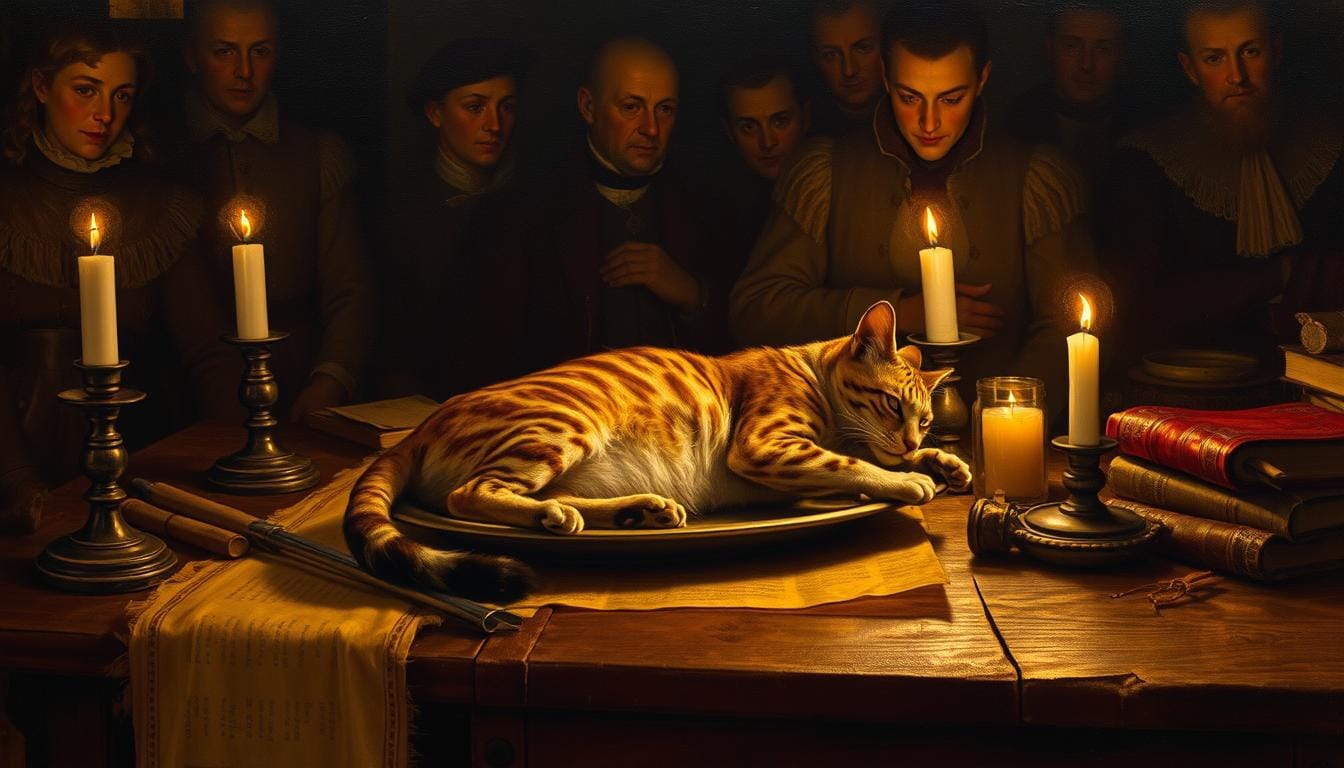What Is Cooked Cat? Meanings and Historical Uses
Imagine living in a time when your next meal wasn’t guaranteed. For many cultures throughout history, survival meant making difficult choices about what to eat. While cats today are cherished companions, their role in human societies hasn’t always been so clear-cut.
Historical records reveal that consuming domesticated feline meat dates back thousands of years. Archaeologists have found wild cat bones in prehistoric human waste, suggesting early humans relied on these animals for nourishment. In ancient southern France, accounts describe this practice during Roman rule, while 18th-century French recipes show it was once part of mainstream food culture.
Table of Contents
You might wonder how such traditions developed. During famines or wars, people turned to unconventional protein sources out of necessity. In some regions, this meat became ingrained in local diets long before modern pet ownership norms emerged. The shift from viewing these creatures as practical resources to beloved family members highlights evolving human-animal relationships.
This exploration isn’t about judgment—it’s about understanding how survival, tradition, and cultural values intersect. As we delve deeper, you’ll discover how geography, hardship, and belief systems shaped these practices across eras. Let’s uncover the stories behind one of humanity’s most complex culinary histories.
Introduction to Cooked Cat
Cultural attitudes toward feline meat reveal striking contrasts across societies. While some groups view it as taboo, others have integrated this protein source into rituals and survival strategies. This duality shows how food practices reflect deeper values shaped by environment, belief systems, and necessity.
Overview of the Topic
You’ll discover this meat often served as emergency sustenance during crises. Both World Wars saw its use when traditional food supplies collapsed. In Cameroon, specific communities still celebrate ceremonial dishes believed to attract prosperity.
Religious rules play a key role too. Islamic and Jewish dietary laws ban its consumption entirely. These restrictions classify felines as predators unfit for human meals.
Historical and Cultural Background
Hardship frequently drove people to unconventional protein sources. Economic collapses and famines forced difficult choices about nourishment. What began as survival sometimes became tradition over generations.
Modern debates spotlight ethical concerns and cultural relativism. As pets gained family status, perceptions shifted dramatically. Yet historical context reminds us that food choices rarely emerge from preference alone.
Understanding the Concept of Cooked Cat

The line between livestock and companion animals shifts with time and necessity. Historically, feline meat served as a protein source prepared through methods similar to poultry or rabbit. You’ll find accounts of roasting, stewing, and marinating techniques across multiple continents.
Preparation required specific skills to ensure safety and taste. Butchers developed techniques to handle lean muscle tissue, often using herbs to balance strong flavors. In some regions, recipes included wine-based sauces or slow-cooking methods to tenderize the meat.
Cultural beliefs deeply influenced these practices. Certain societies attributed medicinal properties to specific cuts, while others linked its consumption to spiritual rituals. These traditions highlight how food choices often reflect deeper worldviews rather than mere survival needs.
Modern perspectives struggle to reconcile this practice with current pet-keeping norms. However, examining historical meat consumption patterns reveals adaptive strategies in food-scarce environments. The evolution from practical resource to protected companion mirrors broader changes in human-animal relationships.
Understanding this concept demands separating modern emotions from anthropological realities. What seems unthinkable today once represented pragmatic adaptation—a reminder that dietary norms remain fluid across cultures and eras.
Historical Uses of Cooked Cat
Throughout history, scarcity forced communities to adapt diets in unexpected ways. When traditional food supplies vanished, people turned to whatever protein sources they could find. This reality shaped culinary practices that might surprise modern sensibilities.

Famine Food and Survival Strategies
You’ll find wartime eras revealing desperate measures. Central Europeans dubbed feline meat “roof rabbit” during the World Wars when livestock vanished. Urban populations relied on these animals due to their availability in cities stripped of resources.
Harsh winters and failed crops pushed rural areas toward similar solutions. Historical accounts show families consuming this meat during Spain’s 17th-century crises. Survival often meant redefining what qualified as acceptable nourishment.
Recipes from Antiquity and Early Modern Europe
French archives preserve detailed instructions from 1740 for preparing feline dishes. These methods mirror poultry techniques—stewing with herbs or slow-roasting to enhance flavor. Such records prove the practice entered mainstream food culture temporarily.
Spanish texts describe marinating the meat in wine to soften its texture. These recipes weren’t secret survival hacks but documented culinary knowledge. They highlight how necessity sometimes blurs lines between taboo and tradition.
Modern Culinary Perspectives on Cooked Cat
Societies worldwide now face a cultural crossroads regarding dietary choices. What was once considered survival food has become a subject of intense debate. Laws and social norms increasingly reflect shifting views on animal welfare and companionship.
Legal and Ethical Considerations
In 2018, the U.S. banned commercial feline meat trade through federal legislation. Violators now face $5,000 fines, except in specific religious contexts. Taiwan set earlier precedents, outlawing sales in 2001 and consumption in 2017 through updated animal protection laws.
Ethical arguments center on pets’ emotional intelligence and family roles. Many question the morality of eating animals that form deep bonds with humans. These concerns drive legislative changes protecting domesticated species.
Changing Dietary Trends
Urbanization and pet ownership rates influence food preferences dramatically. As more people welcome animals into homes, cultural taboos against certain meats strengthen. Western values emphasizing animal rights increasingly shape global policies.
Consider these key shifts in food regulations:
| Country | Legal Status | Year Enacted | Penalties |
|---|---|---|---|
| United States | Commercial ban | 2018 | $5,000 fine |
| Taiwan | Full prohibition | 2017 | Fines up to $8,000 |
| France | No specific laws | – | N/A |
Modern diets reflect evolving relationships with animals. What societies once viewed as protein sources now receive legal protection. These changes highlight how cultural values transform food practices over time.
How to Prepare Cooked Cat Safely
Proper handling techniques ensure safety when processing unconventional protein sources. While modern kitchens rarely encounter this practice, historical methods offer insights into food preparation under extreme conditions.
Butchering and Cleaning Techniques
Begin with sanitized tools: a large cutting board and razor-sharp knife. Remove non-edible parts first—head, tail, and feet require swift, clean cuts. These sections contain minimal muscle tissue and pose contamination risks if mishandled.
Create a precise incision along the abdomen to access the body cavity. Discard all organs immediately, particularly the liver. Though visually appealing, this organ often carries toxins in domestic felines. Rinse the cavity thoroughly with cold water to eliminate residual blood or debris.
Proper Skinning and Handling Methods
Two approaches work for removing protective layers:
- Use knife techniques: Separate skin from muscle with careful slicing motions
- Employ pliers: Grip loose skin near the neck and peel downward
Wash the exposed meat multiple times to remove stray hairs. Maintain strict hygiene—sanitize surfaces and tools between each step. Patience prevents accidents during this delicate process.
Final preparation involves soaking the body in salted water for 30 minutes. This step enhances food safety by drawing out remaining impurities before cooking begins.
Traditional Recipes Featuring Cooked Cat
Historical culinary archives reveal unexpected sophistication in preparing unconventional proteins. These methods mirror techniques used for poultry and game, blending practicality with flavor enhancement strategies.
Beer Roasted Preparation
This method begins with a 24-hour saltwater soak to purify the meat. Chefs then marinate it in Irish stout for six hours – the alcohol’s enzymes break down tough fibers while adding malty notes. Slow-cooking in cream of mushroom soup and beef bouillon creates fall-off-the-bone tenderness, similar to pot roast techniques.
Cheese-Crusted Casserole
The au gratin version transforms diced meat into comfort food. A roux-based cheese sauce (butter, flour, milk) coats each piece before baking. Topped with cheddar and breadcrumbs, this dish mirrors classic chicken casseroles but uses paprika for depth. Uniform dicing ensures even cooking, while familiar ingredients mask any strong flavors.
Both recipes demonstrate how cooks historically adapted challenging proteins into palatable meals. By borrowing from established poultry preparation methods and using pantry staples, these dishes bridged survival needs and culinary tradition.
Innovative Cooked Cat Recipe Variations
Culinary innovation often emerges from blending tradition with modern techniques. Chefs now reimagine historical dishes using contemporary flavor profiles while respecting cultural roots. The French Cat Braisé offers a template for creative adaptations—seasoned meat pieces dusted in flour become a canvas for bold experimentation.
Try marinating the protein in smoked paprika and citrus overnight before slow-cooking. This tenderizes the meat while adding zesty undertones. For richer dishes, deglaze the pan with brandy and stir in tomato paste. These methods balance earthy flavors with brighter notes.
Modern fusion approaches gain traction too. Some chefs pair shredded meat with kimchi in tacos, merging European preparation with Asian spices. Others bake it in phyllo pastry with figs, creating sweet-savory contrasts. Each variation demonstrates how traditional food sources adapt to current tastes.
Ethical considerations remain crucial when exploring these recipes. While historical context informs culinary creativity, modern values prioritize animal welfare. Understanding this balance helps appreciate how food traditions evolve without endorsing outdated practices.
Read also :
- Dry Cat Food Recipes
- Wet cat Food Recipes
- Special Cat Food Recipes
- Chicken Cat Food Recipes
- Homemade Cat Food Recipes
- Can cats eat chicken and what are the health benefits?
- Can cats have chicken as a protein source? Comprehensive guide
- Can Cats Eat Raw Chicken? Safety Guide for Cat Owners
- Dry Cat Food Brands Loved by Cats and Trusted by Vets
- Best Cat Food for Sensitive Stomach:Top 5 Vet-Approved Picks
- Special Kitty Kitten Food – Learn the Pros and Cons
- prescription cat food-Top 10 Prescription Cat Foods
- Wet Cat Food for Kittens: Top Nutritious Choices 2025
- How Long Can Wet Cat Food Sit Out? Critical Facts
- American Veterinary Medical Association (AVMA)

